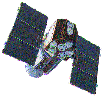News and Events
- 2001: EUVE is switched off on January 31, 2001 after 8.5 years of major
scientific, operational, and technical success.
See the article in
spaceflightnow.
- 2000: EUVE Catches SS Cygni in Outburst. See www.space.com story.
- 2000: EUVE leads super-coordinated, 45-day observation of the binary-star
system EX Hya. See www.space.com story.
- 2000: EUVE continues to operate flawlessly and to return a stream of scientific breakthroughs
in the new field of EUV astronomy. Over
1230 EUV sources have been detected since launch, most of which have been categorized into
appropriate spectral types and optical identifications.
Also, since launch, hundreds of papers
have been published detailing the nature of EUV astrophysics.
All instruments are operating and returning excellent data and science.
- 1999: An updated list of nearly 400 new
EUV sources discovered serendipitously using the scanner telescopes during GO pointed
observations is released.
- 1997: EUVE Project publishes an
all-sky catalogue of 166 faint EUV sources.
- 1997: EUVE Project publishes an
EUV Stellar Spectral Atlas.
- 1997: EUVE takes images of Hyakutake
comet.
- 1996: EUVE mission begins first year of "outsourced" operations at UCB.
- 1996: EUVE Project releases the
second EUVE catalogue, with more than 700 sources over the whole
sky being recorded to date.
- 1994: EUVE Project releases a list of over 100 new
EUV sources discovered serendipitously using the scanner
telescopes during GO pointed observations.
- 1994: UZ Fornacis Animation
- 1994: EUVE mission enters extended mission operations.
- 1993: Following the all-sky survey, a program of pointed spectroscopic observations of individual
targets was begun on January 22, 1993.
- 1993: Total Lunar Eclipse Data
- 1993: EUVE completes first objective, the all-sky survey.
EUVE carried out the first all-sky survey in the extreme ultraviolet wavelength range (100-100 Å)
during the first six months following launch. Concurrent with the all-sky survey, it also made the
first imaging deep survey in this range. EUVE detected a wide variety of astronomical sources
at considerable distances, including some extragalactic objects.
- June 7, 1992:
EUVE Launch Movie
Animated EUVE in Orbit
After years of development followed by numerous launch postponements, NASA's Extreme Ultraviolet Explorer (EUVE) satellite was finally
launched from Cape Canaveral, Florida on a Delta II rocket.
|








